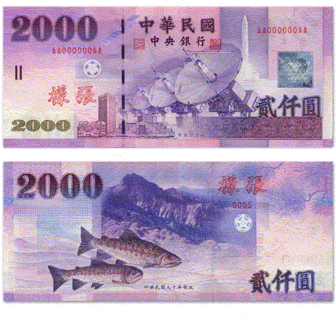The currency name of TAIWAN, PROVINCE OF CHINA is the New Taiwan Dollar

The current denominations in use for the New Taiwan Dollar are the Half Dollar, One Dollar, Five Dollar, Ten Dollar, Twenty Dollar, and Fifty Dollar in the form of circulating coins. Banknotes which are currently in their fifth series of issue include One Hundred Dollars, Five Hundred Dollars, One Thousand Dollars, and Two Thousand Dollars. Oddly enough, both the Two Hundred Dollar Note and the Two Thousand Dollar Note are not generally used; possibly due to the fact that they are new denominations.
Recently, the New Taiwan Dollar has gained in appreciation due to economic speculation; a trend which the policy makers within China's Central Bank have made attempts to prevent. Despite Taiwan's first- quarter Gross Domestic Product forecast being raised to 6.14 percent; far better than the 4.72 percent that was projected a year ago, ground is being gained by the central bank to counter the affects of this. However, strong Taiwanese Dollar values have hurt industries such as Taiwan's textile industry where foreign manufacturers have looked elsewhere to find cheaper materials.
The Central Bank is also currently considering the applications of two Taiwanese banks to provide Taiwan's financial institutions with Chinese Yuan cash settlement services through its Hong Kong branch, to facilitate exchanges in the Chinese currency. This would allow one thousand New Taiwanese Dollars to be saved per every Twenty Thousand Chinese Yuan bought. Besides savings in cost, Yuan currently bought in Hong Kong can be very hard at times to get from the only two sources which happen to be American.
